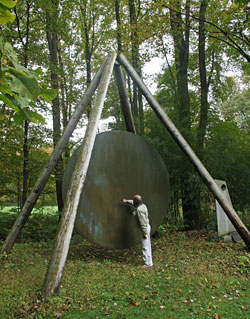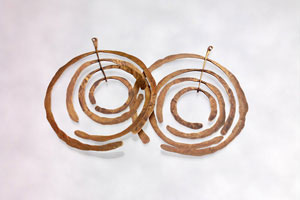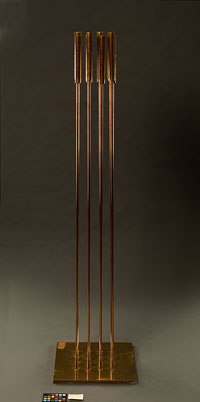Harry Bertoia: Master of Metals
 Val Bertoia activates a sound from a bronze gong his father, Harry Bertoia, created in the mid 1970's. The gong weighs one ton and stands10 feet in diameter. The open pyramid support structure stands 15 feet tall.
Val Bertoia activates a sound from a bronze gong his father, Harry Bertoia, created in the mid 1970's. The gong weighs one ton and stands10 feet in diameter. The open pyramid support structure stands 15 feet tall.Photograph courtesy of Courtney Diener-Stokes
The legacy of Italian-born artist Harry Bertoia is one that reflects his abundant output of creativity during his lifetime. Many of his creations as a jeweler, printmaker, furniture designer and sculptor embody an affinity he had for working with metals such as copper, bronze and brass.
Bertoia’s son, Val, who runs his father’s original studio located in Bally, Pennsylvania, discusses a turning point in his father’s career that involved his relationship with copper.
“Going back all the way to the 1960’s, he began to start using copper and copper alloys to shape out these copper bodies and hollow forms for his sculptures,” Val says. “In the process of hammering the shapes, he discovered that hammering the copper would work harden the copper to the point that it was creating sound.”
He describes how, in comparison to the dull sound created by a standard sheet of copper, the hammered copper created an “amazing sound quality”.
“He found that beryllium copper had the purest sound qualities and then he would design the sound sculptures accordingly,” Val says. “He started inventing new sculptures that would purposely enhance sound.”
Val, also an artist, discusses the breadth of Bertoia’s career that touches upon the physical, visual and audible experiences he created through his work.
“In the 50’s he was designing with the metal contour that would make the human physical body comfortable,” Val says of his father’s furniture designs. “In the late 60’s, he was designing sculptures that would make the human spirit comfortable.”
An upcoming exhibition at the James A. Michener Art Museum in Doylestown, Pennsylvania curated by Director and CEO of the museum, Lisa Hanover, pays tribute to the full scope of Bertoia’s career.
Hanover discusses her personal history with the artist’s work.
 Brass Jewelery design of Harry Bertoia.
Brass Jewelery design of Harry Bertoia. Photograph courtesy of Celia Bertoia
“In my previous incarnation as Director of the Berman Museum of Art at Ursinus College, we had a large and extensive collection of his work,” she says. “I have always been an admirer of Bertoia’s approach to design, sculpture, sound.”
When she took on her roles at the Michener Art Museum last year, she had a realization.
“As I met some of our collectors, Bertoia was a presence in their homes,” she says. In addition, the artist’s ties to the community served as motivation. "It turns out Bertoia was a great network to a number of artists in Bucks County,” Hanover says.
This epiphany was the inspiration behind the new exhibition, Harry Bertoia: Structures and Sounds, on view at the James Michener Museum in Doylestown, PA, from July 20 to October 13. There are some inclusions in the upcoming exhibit that may open up visitors’ eyes to other aspects of Bertoia’s career for which he is not as well known.
“His monoprints were a revelation to me. When you look at the scope and the scale of these pieces, which are incredible compositions, they are fluid, elegant, deliberate, structures,” she says. “A distinctive angle of our installation that we are including is the monoprints.”
According to Hanover, Bertoia used the monoprints in tandem with some of his works. In some cases “you see elements of his furniture and sculptures being worked out in these compositions.”
 Harry Bertoia, Untitled, c. 1968-69, Brass. Woodmere Art Museum: Gift from the collection of Harry and Catherine Kuch.
Harry Bertoia, Untitled, c. 1968-69, Brass. Woodmere Art Museum: Gift from the collection of Harry and Catherine Kuch.Photograph courtesy of the James A. Michener Art Museum)
There will be 36 monoprints on view in addition to a selection of Bertoia’s furniture designs and sculpture, most of which are being borrowed from private collections.
“He is primarily known in one world as a furniture designer and in another world for his Sonambiance,” Hanover says, referring to Bertoia’s tonal sculptures.
The exhibition will bring those worlds together as well as showcase everything in between. That includes approximately ten pieces of Bertoia’s jewelry designs, many crafted from bronze and brass, that will be on view.
“The jewelry itself is sculptural,” she says.
Hanover has been working with Knoll, Inc., where Bertoia was employed as a furniture designer in the early 1950’s, to borrow examples of his output for the exhibit as well as archival photographs of the artist working in the studio at Knoll. She discusses some attributes of Bertoia that impacted his work and differentiated him from other artists of his time.
“I think Bertoia was such a multidimensional person as well as an artist,” she says. “He really wanted our lives to be enriched both aesthetically and physically.”
Examples she used to explain her point involve his furniture designs.
“His chairs are really comfortable, but look so futuristic,” she says. “They are kind of dramatically opposed.”
In addition, Hanover discusses how Bertoia’s copper tonal sculptures have a way of enhancing the environment, particularly with the sounds they make.
Some of Bertoia’s experimentation with metals and tonal sculptures will be included in the exhibit.
“There is a real knowledge base that has to come with these metals,” Hanover says. “This man was a master craftsman when it came to that.” A sound laboratory, established in the 1970’s, is the place where many of the artist’s tonal works are still housed. The laboratory is located in the barn at the Bertoia homestead, located approximately three miles from his studio. Val treats scheduled visitors to a truly unique sound experience to this day.
"I activate the sculptures, but they really play themselves," Val says. He describes the laboratory as the place where his father recorded the sounds his sculptures created when activated to work together in an impromptu, orchestrated fashion.
 Harry Bertoia, Untitled, c. 1970's. Ink on paper, 22 x 27 inches Collection of Celia Bertoia.
Harry Bertoia, Untitled, c. 1970's. Ink on paper, 22 x 27 inches Collection of Celia Bertoia. Photograph courtesy of: James A. Michener Art Museum
“The fact that Val is still carrying on part of the legacy is really neat,” Hanover says.
Val returned to live in his childhood home in 1996. Soon after moving to the Bertoia property, nestled in the woods, Val was inspired to create a sculptural pathway that comprises his own metal sculptures, in addition to that of his father and sculptor Melissa Strawser.
A sculpture that still stands in the same place Bertoia originally placed it on the property, is a large bronze gong he created in the mid 1970’s. The gong, weighing one ton, is 10 feet in diameter and the open pyramid support structure stands 15 feet tall.
"Temporarily, he would place the sculptures on the homeland near the forest for photography purposes," Val says. Due to the size and weight of the piece, the gong became a permanent fixture. Val said his father enjoyed the healing effects of walking in nature just as much as he does today.
“I think his environments have always influenced him,” Hanover says of Bertoia’s work, describing it as organic. “When you are in the gorgeous farmlands of Berks County where he lived, there are so many forms that come into play -- the corn stalks, dandelions, the trees. He just took his inspiration from those things.”
One of Val’s primary aims, in running his father’s studio since his death in 1978, has been to preserve his legacy.
“It is important for me to maintain what Harry established,” Val says. “All of humanity can use less stress and more calm. We have a deeper appreciation of nature through Bertoia copper. His work enhances the spirit.”
Resources:
Also in this Issue:
- Harry Bertoia: Master of Metals
- Tracery 157: Reinterpreting Everyday Objects
- Lost Masterpiece: Wright to offer an important armchair by Walter von Nessen
- Mocahete Reconfigures Copper into Adornment
- Laran Bronze: A Full Service Foundry That Is Home for Skilled Artisans
